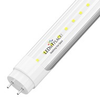One of the recent developments in lighting fixtures for use in commercial (such as offices) and the residential environment has been the LED panel lights that because of their slim and sleek design, and light emitting technology (edge-lit or back-lit) are gaining wide prominence these days. This is also one of those LED light fixtures that have produced a significant impact on the energy producing sector owing to its widespread use resulting in significant savings to the sector. Whether it’s an old office building getting refurbished or a new one coming up, organizations are heavily adopting the use of LED panel lights.
You can have LED panel lights in a wide variety of form, shape or size, but what kind to choose for your environment might seem to be an intriguing question. To satisfy this question, I have taken the initiative to write this blog so that you can arrive at a logical understanding of which panel light to use where.
I am attempting this blog by providing a discussion on LED panel lights under the following subheadings.

Types of LED Panels
LED panels can be classified on the basis of size/shape and light-emission pattern.
Based on Size
One can usually find LED panels in sizes of 1x4, 2x2, 2x4 which means they can be either square-shaped or in the shape of a rectangle. As to what size you should prefer depends on the ceiling space in your home or office when you can install in more than one way. Some manufacturers offer LED panel lights that can be surface-mounted, recessed or suspended while others offer those that come as built-in.
Based on Light-Emission Pattern
There are two kinds of models in LED panel lights that you will come across - edge-lit and backlit. Let’s understand them one by one.
Edge-Lit LED Light Panel
The LED chip being located inside the inner edges of the luminaire, some of the light after entering the light fixture from the sides bounced back, while the major part gets emitted from the surface of the panel. The panels having this kind of light-emission pattern are a great fit for recessed ceilings when the light beam emitted is soft and uniform but not straight-forward -- thanks to the lighting designers who made use of PMMA lens and nano-grade diffusers to achieve such kind of light pattern. The edge-lit panels are thinner in dimension than the backlit panels. If you are up for aesthetics and quality light more than anything else, you may consider having this.
Backlit LED Light Panel
This kind of LED panel was designed with a view to having lighting that is less diffused and more stronger than that emitted by edge-lit. Here, the light gets emitted in the forward direction and gets emitted from the front side of the panel. No light gets wasted here. The backlit panel is thin but thicker in comparison to the edge-lit panel. The only problem you face while making use of backlit panel is -- glare. However, the lower operational costs may entice you to have it.
Let’s get to discuss the second aspect now.
The Problems Posed By Fluorescent Light Fixtures
One of the biggest problems you face when making use of fluorescent lights is its tendency to flicker the moment they are switched On. Think of the immense disruption caused to the workers in any workspace due to the flickering and humming of these lights. The light color variations too in these lights are limited, when you can, at the most, have 3000K and 4000K CCTs (Correlated Color Temperatures) in comparison to LED panel lights where you have 3000K, 4000K and 6500K as options. The 6500K may be utilized for environments where a high level of focus and detail is required. One of the other reasons is the presence of ballast in fluorescent tubes that sipped a lot of energy to produce the same amount of brightness that an LED panel would do by consuming much lesser amount of energy. And finally, also the short lifespan of these fluorescent tubes when at the most these can last is -- 30,000 hours -- 2-3 less in comparison to LED tubes.
And, now the last and the most significant aspect needs to be discussed which will provide you with a clearer picture on LED panel lights.
Why Should you Consider Switching To LED Panel Lights?
The following are some of the topmost reasons (other than what has been mentioned earlier) that should be considered for the switch.
- No flickering or humming observed in these panel lights.
- The LED panel lights as dimmable lights can enable significant savings in energy other than what you save when making a switch from fluorescent lights. Also, the dimming can create a soothing ambiance for you to relax during the downtime.
- The high CRI (80+) enables products to look authentic and real up to 80% precision.
- Safe lighting as these panels neither contain any lead or mercury, nor any UV or IR radiation.
Conclusion
With all that said, the only thing you as a mid-user or end user must keep in mind is -- the seller from where you would be getting these LED panel lights. I say -- investigate before you get into the final purchase.




















































































